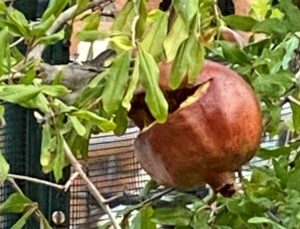I love pomegranates. I have fond childhood memories of my family sitting around the table, each of us carefully peeling the tough husk off and eating the luscious seeds one at a time. We were careful to wear clothing that could be stained with the permanently dyeing juice.
Brought to the Sonoran Desert by Spanish settlers, these trees do well in this dry climate. I have planted a few in my yard, so I can enjoy pomegranates throughout the winter. I usually only consume half the fruit crop, leaving the rest for the birds and other pomegranate-eating animals.
This summer, the monsoons have failed to develop as usual and I’ve only had half an inch of rain fall in my yard, as opposed to the usual four inches by now. The pomegranate fruit stalled in their growth and have been bursting open before the seeds have ripened. They’re still sweet in flavor.
But don’t worry, the pomegranates are being consumed by the locals.
Here, you’ll see a bird hopping in and out of the opening.


Even though I’m disappointed that I won’t get many, if any, pomegranates this year, I am glad that the locals can enjoy them.
 Nothing goes to waste!
Nothing goes to waste!
Pomegranate drawing by Nicky Girly on Pixabay.
